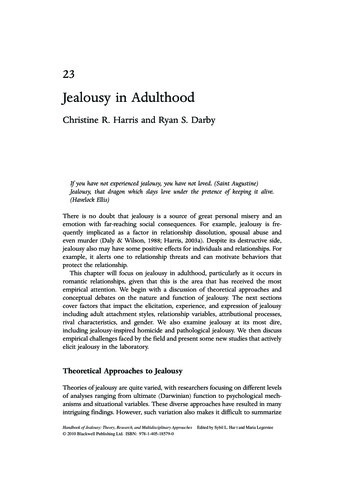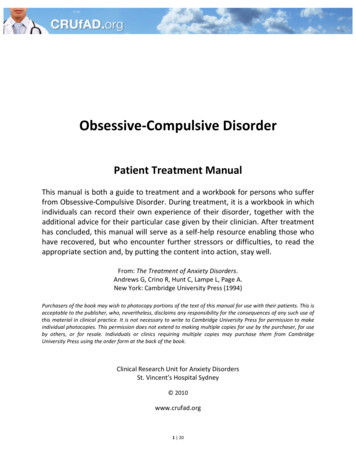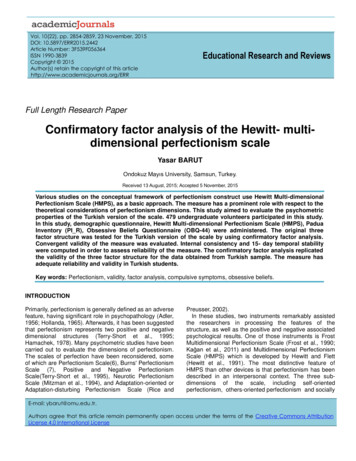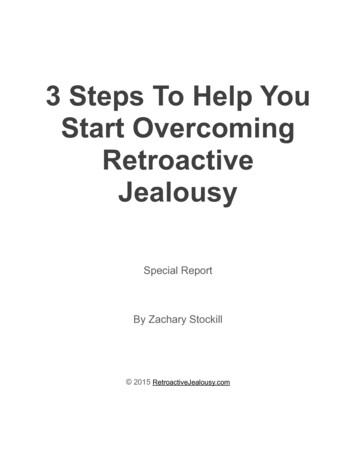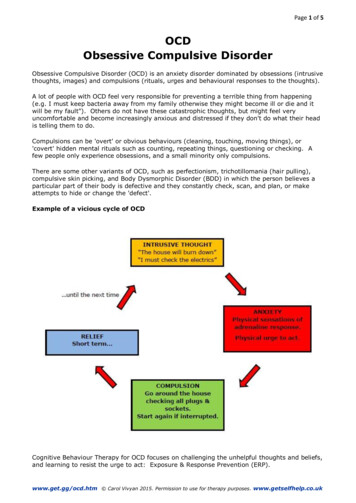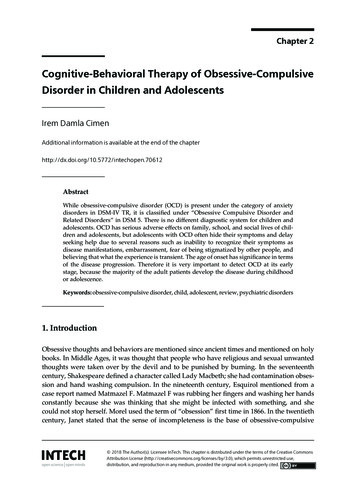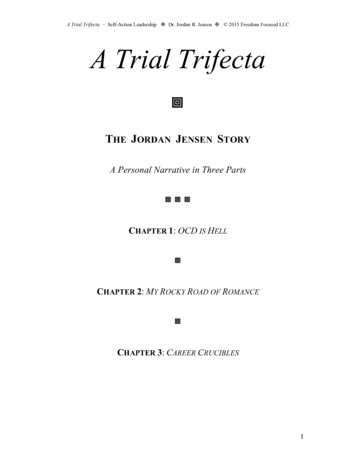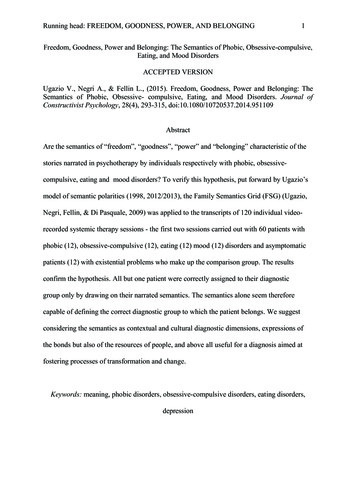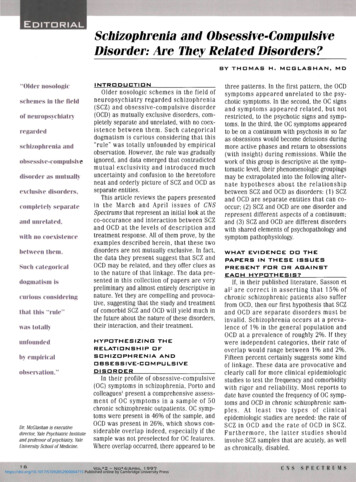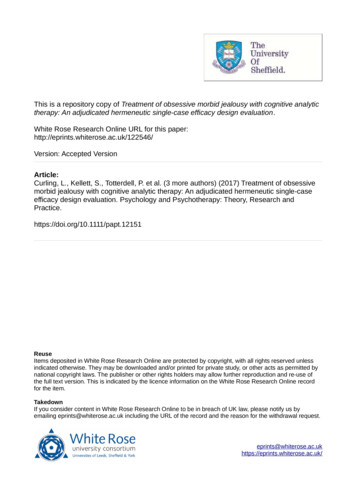
Transcription
This is a repository copy of Treatment of obsessive morbid jealousy with cognitive analytictherapy: An adjudicated hermeneutic single-case efficacy design evaluation.White Rose Research Online URL for this n: Accepted VersionArticle:Curling, L., Kellett, S., Totterdell, P. et al. (3 more authors) (2017) Treatment of obsessivemorbid jealousy with cognitive analytic therapy: An adjudicated hermeneutic single-caseefficacy design evaluation. Psychology and Psychotherapy: Theory, Research eItems deposited in White Rose Research Online are protected by copyright, with all rights reserved unlessindicated otherwise. They may be downloaded and/or printed for private study, or other acts as permitted bynational copyright laws. The publisher or other rights holders may allow further reproduction and re-use ofthe full text version. This is indicated by the licence information on the White Rose Research Online recordfor the item.TakedownIf you consider content in White Rose Research Online to be in breach of UK law, please notify us byemailing eprints@whiterose.ac.uk including the URL of the record and the reason for the withdrawal terose.ac.uk/
AbstractObjective. The evidence base for the treatment of morbid jealousy with integrative therapiesis thin. This study explored the efficacy of cognitive analytic therapy (CAT). Design. Anadjudicated hermeneutic single case efficacy design evaluated the cognitive analytictreatment of a patient meeting diagnostic criteria for obsessive morbid jealousy. Method. Arich case record was developed using a matrix of nomothetic and ideographic quantitativeand qualitative outcomes. This record was then debated by sceptic and affirmative researchteams. Experienced psychotherapy researchers acted as judges, assessed the original caserecord and heard the affirmative versus sceptic debate. Judges pronounced an opinionregarding the efficacy of the therapy. Results. The efficacy of CAT was supported by allthree judges. Each ruled that change had occurred due to the action of the therapy, beyondany level of reasonable doubt. Conclusions. This research demonstrates the potentialusefulness of CAT in treating morbid jealousy and suggests that CAT is conceptually wellsuited. Suggestions for future clinical and research directions are provided.Practitioner points The relational approach of CAT makes it a suitable therapy for morbid jealousy. The narrative reformulation component of CAT appears to facilitate early change inchronic jealousy patterns. It is helpful for therapists during sessions to use CAT theory to diagrammatically spellout the patterns maintaining jealousy.
IntroductionThe early Latin and Greek definitions of jealousy defined the presence of fervour, ardour anda love to emulate (Ortigue & Bianchi-Demicheli, 2011) and jealousy can be experienced attimes in relation to the possessions that another person owns (Belk, 1984). Morecontemporary definitions focus on the romantic interpersonal nature of jealousy and sharecommon elements of the description of a distinct and negative emotional state reactive to theloss (or fear of loss) of a valued relationship, because of the actions of a real (or imagined)rival for a partner’s affections (Rydell & Bringle, 2007). In 1910, Carl Jaspers wrote the firstground breaking clinical description of morbid jealousy (Hoenig, 1965). Morbid jealousyconcerns intra and interpersonal elements of jealousy-fuelled anxiety and paranoia focussedon partner infidelity that create dependency, frequent interrogation, being generallyuntrusting, behaviourally checking for evidence of infidelity and also the presence of ragestates when suspicions are aroused (Kingham & Gordon, 2004).Morbid jealousy has been clinically separated into either delusional or obsessivesubtypes (Cobb, 1979; Shepherd, 1961). Delusional morbid jealousy (DMJ) involves thebehavioural expression of rigid and persecutory beliefs concerning a partner’s sexualinfidelity, most often located in psychosis (Kingham & Gordon, 2004; Mullen, 1991) orstroke (Ortigue & Bianchi-Demicheli, 2011). Obsessive morbid jealousy (OMJ) has beenlikened to obsessive-compulsive disorder, due to the presence of jealous obsessive intrusionscreating paranoia/anxiety and associated compulsive safety-seeking behaviours (Cobb &Marks, 1979). Examples of jealous compulsions are checking a partner’s underwear for signsof sexual behaviour, controlling behaviours, interrogating and checking of mobilephones/social media. OMJ patients tend to have insight into their irrational jealousy(Kingham & Gordon, 2004) and often experience associated heightened shame (feelings ofself-humiliation) and guilt (awareness of the impact of jealousy on relationships).
A wide variety of theoretical perspectives have been posited in the treatment literatureconcerning OMJ and to some extent theory dwarfs available sound outcome evidence(Ortigue & Bianchi-Demicheli, 2011). Psychodynamic theory considers repressed sexuality(Freud, 1922), oedipal rivalry (Klein, 1957) or insecure attachment styles (Dutton, et al.1994) as important underlying and predisposing factors. Cognitive theorists alternativelymaintain OMJ is characterized by core beliefs regarding personal inadequacy andmisinterpretation of events activating faulty assumptions (Tarrier et al. 1990). Behaviouralsystems theorists maintain jealousy is the emotional expression of interacting and circularinterpersonal processes which are played out between partners (Crowe, 1995; Margolin,1981; Teismann, 1979).Given the often devastating psychoemotional impact of OMJ (Cobb, 1979) creatingassociated risks of suicide (Mooney, 1965; Shepherd, 1961), domestic violence (Dell, 1984;Mullen, 1990; Mullen & Maack, 1985) and substance misuse (Tarrier et al, 1990;Vauhkonen, 1968), the thorough evaluation of interventions for OMJ are clearly warranted.However, the evidence base regarding psychotherapy for OMJ is currently limited, withstudies tending to be practice-based and uncontrolled. For example, early studiesdemonstrated the effectiveness of behavioural therapy (Cobb & Marks, 1979), cognitivetherapy (Bishay, Peterson & Tarrier, 1989), cognitive behavioural therapy (Marks & DeSilva, 1991; Dolan & Bishay, 1996a) and eye movement desensitization and reprocessing(EMDR; Keenan & Farrell 2000). More recently, integrative therapies have been shown tobe effective (Kellett & Totterdell, 2013, Lopez, 2003). Only one outcome study has used acontrol group for comparison purposes; Dolan & Bishay (1996b) allocated to a waitlistcontrol condition, to show that CBT was associated with significant reductions in jealousy.Outcome studies of psychological interventions for OMJ have dwindled in recent years.
Whilst considered the methodological ‘gold standard’ of clinical research, randomizedcontrolled trials (RCTs) of OMJ treatment appear difficult to complete due to relative rarityof cases presenting to services (Kingham & Gordon, 2004). RCTs have also been criticizedfor compromising ecological validity through prioritizing high methodological control overconfounding factors (Barker, Pistrang & Elliott, 2002). Given these recruitment andmethodological dilemmas, use of single case experimental design (SCED) offers analternative, ecologically valid and pragmatic tool for evaluating the effectiveness of OMJtreatments offered in routine service settings. SCED particularly makes a valuablecontribution, when the evidence base for a treatment is in its empirical infancy (Barlow, Nock& Hersen, 2008).However, demonstrating therapeutic efficacy with SCED is a challenge, as adaptationsto the method are required to create evidence that the treatment was directly responsible forchange (Bohart & Boyd, 1997; as cited in Elliot et al. 2009, Elliott, 2002). There areexamples of randomized single case studies of pharmacotherapy, in which a therapeuticprocedure is compared with placebo or where two treatments are compared by administeringthe two conditions in a predetermined random order (Backman & Harris, 1999). A conditionof such studies is that neither the participant nor the clinician is aware of the treatmentcondition during any given period of time. Such designs are impossible with psychotherapy.In response, hermeneutic single case efficacy design (HSCED) has been developed as aparadigm within which efficacy can be demonstrated at the level of the individual patientreceiving psychotherapy (Elliott, 2002; Elliott et al. 2009).HSCED is a practical reasoning system and critical-reflective approach, which aims toidentify and evaluate the effective elements of a model of therapy that directly create change(Elliott, 2002, Elliot et al. 2009). HSCED involves the development of a rich case record of atherapy, which is then systematically evaluated to develop skeptical and affirmative
interpretations of therapeutic outcome. Demonstration of efficacy in HSCED requires threeor more pieces of supporting evidence that link the therapy to positive clinical change; (a)retrospective attributions, (b) process-outcome mapping, (c) within therapy process-outcomecorrelation, (d) changes in stable problems or (e) event-shift sequences (Elliott 2002; Elliottet al. 2009). The skeptical position argues that change was absent, trivial or the result ofstatistical, relational and/or research and measurement artefacts. HSCED has been recentlyenhanced to include an ‘adjudicated HSCED’ approach, which mimics the legalisticevaluation framework, in that expert psychotherapy researchers as ‘judges’ to determineclinical outcome (Elliott et al. 2009). The rationale for adding an adjudication process toHSCED, is that adjudication adds another layer to the systematic judgement process in theconsideration of efficacy at the individual case level (Stephen & Elliott, 2009). In thisprocess, decisions regarding arbitration are based on the legal criteria of ‘beyond reasonabledoubt’ when looking across multiple sources and types of outcome evidence (Elliot et al.2009). A recent example an adjudicated HSCED is Benelli et al.’s (2017) evaluation of thetransactional analysis treatment of depression.The current study conducted an adjudicated HSCED evaluation of cognitive analytictherapy (CAT) for OMJ. The rationale for the use of CAT is that because OMJ containsstrong relational elements (e.g. fear of abandonment; Kingham & Gordon, 2004), then arelational therapy would be able to formulate such patterns and also use theory to analysewhen enactments of associated relational dynamics occurred within the therapeuticrelationship (e.g. experience of abandonment on termination of therapy). No adjudicatedHSCED evaluations of CAT for any clinical diagnosis have previously been conducted andso the current study is clinically and methodologically innovative. Whilst there is SCEDevidence that CAT can be an effective approach for OMJ (Kellett & Totterdell, 2013), thecurrent study sought to build on that empirical foundation through the use of an adjudicated
HSCED process. The aims of this study were to assess the efficacy of a 16-session CATtreatment for OMJ and identify the mechanisms creating therapeutic change.MethodEthics, participant and therapistApproval from ethics and information governance committees was provided to analyse thedata and consent was sought from the patient (ref: 12/YH/0310). The therapist was a maleConsultant Clinical Psychologist and accredited CAT therapist and supervisor, with elevenyears of post-qualification experience. A 38-year-old female participant was recruitedfollowing a screening for a 16-session CAT intervention. The assessment of the clientfollowed the Kellett, Boyden & Green (2012) assessment procedures and highlighted OMJbeing the primary diagnosis. The participant reported seeking help due to a deterioration inher chronic jealousy caused by the discovery of a brief, 6-week, affair conducted by herhusband. She reported (even prior to the affair) frequent intense anxiety around herhusband’s fidelity and was now extremely anxious about the likelihood of him meetinganother woman. She noted that she had been excessively jealous across all her adultrelationships and had strong dependent traits in relationships. The participant describedgetting ‘locked into’ jealous states of mind and losing all perspective. The participantexperienced high frequency vivid and intrusive images of the husband having sex with otherwomen and also obsessive intrusive thoughts centring on a theme of infidelity. She alsoreported the presence of the compulsions of repeated reassurance seeking concerning fidelity,checking, presentism in the relationship and frequent interrogation of her partner. Theparticipant reported always having low self-esteem and poor body image and that the affairhad triggered a depressive episode. The participant reported engaging in prolonged
rumination about the circumstances surrounding the affair. There was no history of selfharm. A course of SSRI medication was initiated prior to the commencement of therapy andwas unchanged throughout all study phases. No psychotherapy of any model had beenpreviously attempted. Childhood experiences included modelling of over-dependency on herfather by her mother (who experienced severe mental health difficulties). The participantreported a chronic sense of abandonment and rejection from her childhood years.TreatmentTreatment was delivered under routine care conditions in the National Health Service (NHS)in the UK. CAT is a relational, collaborative and time-limited (8, 16 or 24 session)psychotherapy originally designed to meet the organizational demands of public mentalhealth services (Ryle & Kerr, 2002). CAT integrates cognitive (via detailing proceduralsequences) and analytic (via reciprocal roles) methods and theories to enable a structured andcontaining treatment approach (Ryle & Kellett, 2017). CAT therefore emphasizescollaboration between therapist and patient during exploration, description and analysis ofhow past (often childhood) childhood experiences contribute to the development of currentlyrestrictive or harmful relationship roles and associated patterns. As these reciprocal roles actas templates for relationships, then they also occur within the therapeutic relationship, where‘enactments’ are frequently analysed as a key change method (Bennett & Parry, 2004).The treatment methods of CAT have been clearly established and delineated (Ryle &Kerr, 2002) and in complex cases are based on the multiple self-states model (MSSM; Ryle,1997). The MSSM defines the operation of recognizable, discrete self-states, each with acharacteristic affect, sense of self and mode of relating to others that a patient can alternaterapidly between. CAT in the current study also reflected the established three-phaseapproach (Ryle & Kerr, 2002): (1) a ‘reformulation’ phase of extended assessment leading toa narrative reformulation of the participant’s morbid jealousy, (2) a ‘recognition’ phase to
encourage enhanced self-awareness via production of a sequential diagrammaticreformulation (SDR) and associated self-monitoring of patterns, roles and states and (3) a‘revision’ stage focused on changing jealous patterns and roles via identifying ‘exits’ on theSDR, followed by ‘goodbye letters’ written and exchanged by therapist and patient at thefinal session.The narrative reformulation was therefore a statement of the OMJ using CAT termssuch as roles and procedures and the SDR was a diagrammatic representation of the sameroles and procedures. The SDR for the participant contained the following self-states;jealousy (using an abandoning to abandoned reciprocal role), clinginess (using a rejecting torejected reciprocal role) and dependency (summarized by an enmeshed Venn-diagram).These were all connected by procedural sequences, to emphasize the means by which theparticipant shifted between states or alternated between the poles of reciprocal roles. Forexample, feeling abandoned the participant’s aim would be to elicit ‘perfect love’ whichwould crumble due to jealous intrusions forcing the participant to seek reassurance, whichdrove her partner away and so she experienced him as distant and therefore potentiallyabandoning. The final revision phase entailed five change methods: (1) analysis of reciprocalrole enactments in the therapeutic relationship, (2) engaging in alliance rupture-repairsequences, (3) exposure to jealous obsessive thoughts and images, with response preventionto associated compulsions, (4) emphasizing appropriate independence in relationships and (5)development of a more effective model of self-care. Consistent with CAT practice, changeswere visually labelled as ‘exits’ on the SDR (Ryle & Kerr, 2002).Research teamsTrainee clinical psychologists were recruited to act as affirmative (AT, N 3) and scepticresearch teams (ST, N 3). Team members had to meet the following criteria: successfulprogression into the final year of clinical psychology training, experience of completing a
SCED in their own practice, experience of research beyond undergraduate level, skills incritical and reflective evaluation and openness to considering either positive or negativeaspects of an integrative therapy.JudgesThe team of ‘judges’ (N 3) was specifically selected to ensure representation of divergenttheoretical orientations. In practice, this meant CAT, CBT and psychodynamicpsychotherapy. Judges had to meet the following criteria: recognized expertise in specifictherapeutic modality, academic prominence as a psychotherapy researcher and an expressedappreciation of the utility of a range of therapeutic models.Design and materialsThe participant completed a range of nomothetic and ideographic outcome measures. Thefour nomothetic psychometric measures were completed at assessment, termination andfollow-up and the six ideographic measures were completed via a daily diary throughout thephases of the study (baseline, treatment and follow-up). Ideographic measures thereforetracked jealousy across the baseline (‘A’), treatment (’B’) and follow-up phases to create anA/B with follow-up SCED. Baseline (A) consisted of purely assessment activity (3 sessions)and this data was used as a comparator for outcomes during active treatment (B; 13 sessions)and follow up (1 session; 11-weeks post treatment). Treatment (‘B’) was initiated by meansof delivery of the narrative reformulation in session 4, to be consistent with the previous CATjealousy SCED (Kellett & Totterdell, 2013).Nomothetic quantitative measures and associated analysis strategyPrestwich Jealousy Questionnaire (PJQ). The PJQ is a 60-item measure of cognitive,affective and behavioural aspects of jealousy (Beckett, Tarrier, Intili, & Beech, 1992; as citedin Intili & Tarrier, 1998). A score of 50 indicates clinically significant levels of jealousy(Intili & Tarrier, 1998). Overall PSQ scores are classified as no jealousy (0-33), mild
jealousy (34-49), moderate jealousy (50-99), severe jealousy, (100-132) and very severejealousy ( 133). Beck Depression Inventory-II (BDI-II). The BDI-II is a 21-item measure ofdepression with sound reliability and validity (Beck, Steer, Ball and Ranieri, 1996; Beck,Steer and Brown, 1996). BDI-II scores are classified (Beck, Steer & Brown, 1996) as:minimal depression (0-13), mild depression (14-19), moderate depression (20-28) and severedepression (29-63). Inventory of Interpersonal Problems-32 (IIP-32). The IIP-32 measuresinterpersonal difficulties and has been subject to confirmatory factor analysis (Hughes &Barkham, 2005). The IIP-32 has high internal consistency and test-retest reliability, with aclinical cut-off of 1.50 for the full scale (Barkham, Hardy & Startup, 1996). Brief SymptomInventory (BSI). The BSI (Derogatis, 1993) is a 53-item measure of psychological distressacross nine symptom dimensions and three composite scores (global severity index, positivesymptom total and positive symptom distress). The BSI has sound psychometric propertieswhen used with psychiatric disorders and caseness is indicated by a global severity index tscore of 63 (Derogatis & Melisaratos, 1983).Nomothetic outcomes were evaluated in terms of both reliable and clinicallysignificant change. The reliability of change was assessed using the reliable change index(RCI, Jacobson & Truax, 1991). The RCI indexes the degree of change necessary in anoutcome score for that change to be considered reliable, rather than a reflection of possiblemeasurement error. Clinically significant change (CSC, Jacobson & Truax, 1991) occurswhen outcomes shift in classification from ‘caseness’ to ‘non-caseness’. In practice-basedresearch, simultaneous reliable and clinically significant change is considered as evidence of‘recovery.’ Unfortunately, it was not possible to complete RCI analysis for the PJQ, due tolack of necessary psychometric properties.
Ideographic quantitative measures and associated analysis strategyIdeographic measures were collected continuously over N 193 days and the diary wascollaboratively designed in the first session. Wording of measures and scale anchors arefound in Table 1. Ideographic outcomes were graphed according to study phase withassociated statistical comparisons between the phases. The degree of serial dependencywithin each phase was evaluated with autocorrelation analysis (Huitema & McKean, 1991)and differences between phases assessed via analysis of covariance (ANCOVA). Thisinvolved the creation of a variable using the lag-order coefficient which most stronglycorrelated with the time series. For all ideographic measures, autocorrelation was strongestfor the first-order lag, which was then used as a covariate in the ANCOVA to control forserial dependency (Totterdell & Kellett, 2008). The ANCOVA had a single factor for stageof treatment which had three levels (baseline, treatment and follow-up). For eachideographic measure, trend lines for each phase of the study were fitted to the time seriesoutcome graph. Post-hoc pairwise comparisons were also used to test which phases weresignificantly different from each other and Bonferroni corrections were used to control thefamilywise error rate and reduce the likelihood of Type-1 errors.Where significant overall treatment effects were found, then effect sizes were thencalculated using non-regression based non-overlap metrics, to evaluate the magnitude of theintervention effect (Horner et al, 2005). Specifically, data from the treatment phase and thefollow-up period were combined and compared to baseline data using the percentage of datapoints exceeding the median (PEM; Ma, 2006). Estimates of effect size based on PEM wereinterpreted as 70% ‘questionable/ineffective treatment’, 70-90% ‘moderately effectivetreatment’ and 90 % ‘highly effective treatment’ (Wendt, 2009).
Qualitative evidenceThe Change Interview (CI) is a semi-structured interview protocol used to explore theparticipant’s experience of therapy, identify changes (if any) which have occurred andconsider what may have facilitated or created change (if change occurred). During the CI,ratings (on a 1-5 Likert scale) are made of how expected changes were, how likely changeswould have been without therapy and how important changes were. The CI was conductedfollowing the completion of the follow-up period. As part of the CI, the participant alsocompleted the Helpful Aspects of Therapy (HAT; Llewelyn, 1988). The HAT is a 7-iemself-report instrument that gathers information about the patient’s experience of helpful andhindering events during psychotherapy. The HAT asks participants to name and rate specificaspects of a psychotherapy session (or events outside of psychotherapy session) that werehelpful (1-9 Likert rating) or hindering (1-9 Likert rating). The HAT is typically used postsession, but in the current study the wording of the HAT was altered to reflect the entiretherapy.ProcedureThe remaining HSCED procedure was conducted in three phases:Phase 1: Development of the rich case record. This consisted of nomothetic andideographic outcomes (graphed and tabulated with associated statistical analyses), CItranscript, HAT form, therapist anonymized clinic notes and narrative/diagrammaticformulations. The ideographic diary also contained space for writing a qualitative descriptionof that particular day and in the rich case record qualitative entries (N 137) were groupedaccording to study phase. Qualitative diary entries were subject to content analysis(Krippendorf, 2014) to determine the number of references made to jealousy, specific andgeneral aspects of therapy and references to events outside therapy. For the content analysis,each diary entry constituted a measurement unit and was coded for the presence or absence of
references to the specified criteria (see Table 4). The coding criteria created reflected theHSCED method of holding a skeptical position that change may be caused by factors beyondtherapy. Units were coded independently by two coders (trainee clinical psychologists notpart of the sceptic or affirmative teams), after practicing with 10 randomly selected unitsfrom the diary. The two sets of codes were compared, resulting in a 71% agreement rate.Phase 2: Development of briefs and rebuttals. Affirmative and sceptic teams werepresented with the rich case record. Teams were asked to explore the case record and seekout information which supported respective positions. Such information was then collated inthe form of comprehensive ‘brief.’ Once both sceptic and affirmative briefs were developed,each team met again to review the opposing teams brief in order to generate a ‘rebuttal’statement.Phase 3: Adjudication. Judges were provided with the original rich case record and copiesof the AT and ST’s briefs and rebuttals. Judges were requested to carefully review anddecide on the most comprehensive and convincing argument. Judges were asked to write areview explaining their decision on which brief they supported and the key pieces ofinformation influencing this process.ResultsIdeographic quantitative outcomesMeans on the ideographic jealousy measures by study phase with an associated comparisonof phases (ANCOVA) are reported in Table 1. Exact p values for main effects, post hocstudy phase comparisons and effect sizes are reported in Table 2.Insert tables 1 and 2 here please
There was a significant effect of treatment phase on jealousy and a moderately effectiveintervention (see Figure 1). There was no effect of treatment phase on compulsiveobservation and an ineffective treatment (see Figure 2). There was a significant effect oftreatment phase on state-shifting and a moderately effective intervention (see Figure 3).There was a significant effect of treatment phase on anxiety and a moderately effectiveintervention (see Figure 4). There was a significant effect of treatment phase on self-esteemand a moderately effective intervention (see figure 5). There was a significant effect of phaseon being in balance and a highly effective intervention (see Figure 6).Insert figures 1-6 here pleaseNomothetic quantitative outcomesNomothetic outcomes are reported in Table 3 and Table 4 reports an analysis of the subscalesof the IIP-32. Reliable and clinically significant change occurred between assessment andtermination in terms of depression (BDI-II) and global psychological distress (BSI-GSI). Nofurther reliable improvement (nor deterioration) in depression or global distress occurredbetween termination and follow-up. Scores on the PJQ showed a reduction in jealousy from‘severe’ at assessment, to ‘moderate’ at termination and ‘mild’ at follow-up. Full IIP-32scores showed little change (Table 3), whereas analysis of the subscales (Table 4) showedreliable pre-post reductions in dependency, but a reliable increase in finding it difficult to besociable between end of treatment and follow-up.Insert Table 3 and 4 here please
Qualitative content analysis of the diaryFrequencies of diary entries are reported in Table 5. The content analysis suggests thatjealousy was fixed during the baseline and then more variable (i.e. improving and alsodeteriorating) during treatment. Therapy was helpful on an ongoing basis and external eventsexerted a negative influence.Insert table 5 here pleaseChange interview and HATThe change interview results are summarized in Table 6. The participant reported almost allchanges as extremely important, unexpected and also unlikely without therapy. The mostunexpected changes were being more mindful (unlikely without therapy), more independentwithin the marriage and less obsessed about the affair (both unlikely without therapy). Somechanges had been expected prior to therapy such as less obsessing about weight. Nothing hadchanged for the worse, although there had been a hope for greater self-confidence and also tocompletely extinguish the jealous intrusive thoughts. Change was attributed to therapy andseveral technical aspects of CAT were rated as extremely helpful in bringing about change(e.g. reformulation and goodbye letters and creation and use of the diagrammaticreformulation). The aspects of the HAT scored as very helpful were as follows: completingthe diary, the therapist framing the problem as like OCD, learning to prevent rumination,acceptance of the husband’s behaviour, recognizing that change was possible with regards tojealousy, recognizing the influence of childhood factors, narrative reformulation and goodbyeletters, the therapist drawing out patterns during sessions and finally actively using the SDRto recognize these patterns between sessions. No aspects of CAT were reported to have beenhindering.Insert table 6 here please
Development of briefs and rebuttalsAffirmative brief. The affirmative team (AT) argued that jealousy reduced over the course oftherapy and
Silva, 1991; Dolan & Bishay, 1996a) and eye movement desensitization and reprocessing (EMDR; Keenan & Farrell 2000). More recently, integrative therapies have been shown to be effective (Kellett & Totterdell, 2013, Lopez, 2003). Only one outcome study has used a control group for comparison pur
